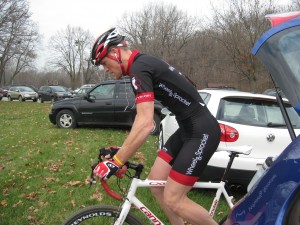The Warm-Up

Before we even consider what temperature cyclocross is raced at, the nature of the sport makes a good warm-up imperative. Cyclocross is a relatively short endurance event that begins with an all out effort. These two factors alone necessitate that athletes allow for enough time to warm-up and pay close attention to how they do it. Throw in the environmental factor of cold temperatures and the importance of the warm-up increases.
Warm-ups before endurance events allow for multiple beneficial physiological processes to occur. The warm-up increases cardiac output and dilates capillary beds in working muscles. It also increases the temperature of the muscle, which in turn increases the rate of the enzymatic reactions occurring in the muscle. This increase in the rate of enzymatic reactions will continue to occur until the temperature reaches a point where it begins to denature (cook) the enzymes of the reaction, decreasing their ability to catalyze. Increasing the body’s temperature also warms connective tissues such as ligaments and tendons, helping to reduce the possibility of injury. This is especially important in cyclocross where athletes do dynamic movements like dismounting, remounting, and running barriers. Also, besides getting the body physically ready to perform the exercise at hand, the warm-up should also be a time for the athlete to mentally prepare for the event.
Warm-ups for cyclocross races differ from warm-ups for other cycling races and warm-ups for cyclocross races in the cold differ from cyclocross races in warmer conditions. When warming up for a cold cyclocross race, warming up indoors or in some kind of shelter on a trainer while wearing warm clothing is ideal. This reduces the rate of convection and increases the rate of warming while reducing the time needed to warm-up. This reduction in warm-up time helps to spare glycogen stores and reduces chances of fatiguing before racing. The warm-up should be done in increments from low intensity to high intensity. It takes ~10 minutes for a muscle to reach thermal steady state at a given output of work. This means a warm-up should be at least 10 minutes in length, but a 20-30 minute warm-up on the trainer is not unheard of, and is often encouraged- as long as the intensities are not fatiguing the athlete. A good guideline for when to end a warm-up is when the athlete begins to sweat. This signifies the body is beginning to thermoregulate itself because the upper level of its thermal tolerance is being reached. A little bit of sweat is good, but be careful not to sweat too much. Too much sweat can steal body heat and reduce core temperature when the warm-up exercise has ceased.
As mentioned before, the mental aspect of the warm-up is also important. This can be divided into pre-competition visualization and “last minute practice”. For the cross racer, visualization includes positive imaging of riding the course and how the start should go. A great time to do this is while riding the trainer. “Last minute practice” includes pre-riding the course and “sessioning” obstacles. It is very important to allow time for this in the warm-up. Also, be sure to dress warmer while pre-riding than what you would when you race, since you most likely won’t be pre-riding the course at the intensity you would during a race.
Allow for at least 5 to 10 minutes of rest between the warm-up and the competitive event. In cyclocross this is not difficult to do because of how long it takes to line-up races and start them. The major concern, especially in cold temperatures, is cooling down too much prior to the race. It is in the best interest of the racer to wear their warm-up clothes to the line and remove them as the time approaches for them start. Ideally, a friend or family member can grab your warm-up clothing from you at the beginning of the race.
Brooks, G.A., Fahey, T.D., Baldwin, K.M. (2005). Exercise physiology: human bioenergetics and its applications (4th ed.). McGraw Hill.
